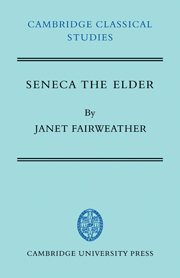Book contents
- Frontmatter
- Contents
- Preface
- Abbreviations
- PART I THE PLACE OF SENECA THE ELDER IN LITERARY HISTORY
- 1 Seneca the Elder: a man of his time
- 2 The declamatory anthology
- 3 The criticism
- PART II SENECA THE ELDER ON THE HISTORY OF ELOQUENCE
- PART III FIVE ASPECTS OF DECLAMATION: THE ELDER SENECA'S EVIDENCE
- PART IV THE PLACE OF EARLY IMPERIAL DECLAMATION IN LITERARY HISTORY: THE ELDER SENECA'S EVIDENCE
- Indexes
1 - Seneca the Elder: a man of his time
Published online by Cambridge University Press: 10 March 2010
- Frontmatter
- Contents
- Preface
- Abbreviations
- PART I THE PLACE OF SENECA THE ELDER IN LITERARY HISTORY
- 1 Seneca the Elder: a man of his time
- 2 The declamatory anthology
- 3 The criticism
- PART II SENECA THE ELDER ON THE HISTORY OF ELOQUENCE
- PART III FIVE ASPECTS OF DECLAMATION: THE ELDER SENECA'S EVIDENCE
- PART IV THE PLACE OF EARLY IMPERIAL DECLAMATION IN LITERARY HISTORY: THE ELDER SENECA'S EVIDENCE
- Indexes
Summary
The elder Seneca had every reason to consider himself singularly well-equipped for the task he was undertaking when he compiled the work which has come down to us under the title Oratorum et rhetorum sententiae divisiones colores. This task was to provide a detailed record of the rise of the type of rhetorical declamation which had become a remarkably important feature of the literary life of Rome in the early years of the Empire, that is, the declamation of controversiae (speeches for the prosecution or defence in imaginary court cases) and suasoriae (speeches offering advice to mythical or historical figures as they face crucial decisions), in public as well as in private, by adult amateurs – often eminent men – as well as by schoolboys and professional teachers of rhetoric.
Born most probably in the fifties B.C., at any rate back in the days when Cicero had still been alive, by the time he came to write his work on the declaimers the elder Seneca was able to draw on an unusually intimate knowledge of his subject acquired over seventy years or more. He could remember the days before public declamation by non-professionals had become accepted practice (Contr. X pr. 4: …nondum haec consuetudo erat inducta), and he knew that it was in the last years of the Republic, when he was a child, that the word declamare had first been used as a technical term to describe the habit, newly popular among Roman orators, of delivering practice speeches in the privacy of their homes (Contr. I pr. 12).
- Type
- Chapter
- Information
- Seneca the Elder , pp. 3 - 26Publisher: Cambridge University PressPrint publication year: 1981



